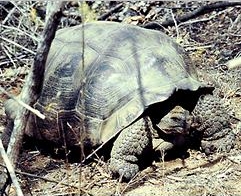Biology:Chelonoidis microphyes
| Chelonoidis microphyes | |
|---|---|

| |
| Chelonoidis microphyes | |
| Scientific classification | |
| Domain: | Eukaryota |
| Kingdom: | Animalia |
| Phylum: | Chordata |
| Class: | Reptilia |
| Order: | Testudines |
| Suborder: | Cryptodira |
| Superfamily: | Testudinoidea |
| Family: | Testudinidae |
| Genus: | Chelonoidis |
| Species: | C. microphyes
|
| Binomial name | |
| Chelonoidis microphyes (Günther, 1875)
| |
| Synonyms | |
| |
Chelonoidis microphyes, also known as the Volcán Darwin giant tortoise, Darwin Volcano giant tortoise or Tagus Cove giant tortoise, is a species of giant tortoise endemic to the Galápagos archipelago in the equatorial eastern Pacific Ocean. The specific epithet microphyes (“small when full-grown”) is based on the mistaken assumption by describer Albert Günther that the holotype specimen (with a carapace length of only 57.2 cm) was of an adult male.[2]
Taxonomy
This tortoise is a member of the Chelonoidis niger species complex, and is sometimes considered to be a subspecies of C. niger. The type locality is Tagus Cove, near the base of Darwin Volcano on Isabela Island.[3]
Description
Male tortoises grow to about 135 cm and females to about 86 cm in length, with domed carapaces.[2]
Behaviour
The tortoises are mainly active in the early morning and late afternoon, resting in shade during the hottest part of the day and sleeping beneath shrubs at night. After heavy rain they wallow in muddy pools. Adults migrate seasonally from the caldera of the volcano to its lower slopes to graze on vegetation after wet season rains.[2]
Feeding
The tortoises feed on grass, leaves, berries and lichens in the wet season, and mainly cacti in the dry season.[2]
Breeding
Male tortoises compete with each other by extending their necks, gaping, biting and pushing. They utter loud guttural noises while mating. Females start nesting in May and June at the end of the wet season.[2]
Distribution and habitat
The tortoise's range is limited to an area of about 67 km2 on the south-western slope of Darwin Volcano on the northern part of Isabela Island. There it inhabits deciduous and evergreen forests as well as dry grassland.[2]
Conservation
The tortoise population is estimated to comprise some 500–1,000 mature individuals, a decline of 94% since 1840, and the species is considered to be Endangered. The tortoises were historically overexploited for food and oil by sailors and settlers. Ongoing threats include predation of eggs and hatchlings, as well as habitat degradation, by introduced animals, including dogs, cats, rodents, pigs and goats. Volcanic eruptions also threaten the tortoises and their habitat.[2]
References
- ↑ Cayot, L.J., Gibbs, J.P., Tapia, W. & Caccone, A. (2018). "Volcán Darwin Giant Tortoise". IUCN. https://www.iucnredlist.org/species/9025/116506297.
- ↑ 2.0 2.1 2.2 2.3 2.4 2.5 2.6 Arteaga, A; Bustamante, L; Vieira, J; Guayasamin, JM (2020). Reptiles of Ecuador: Life in the middle of the world. Quito: Universidad Tecnológica Indoamereica. https://www.tropicalherping.com/science/books/reptiles/reptiles_of_ecuador.html.
- ↑ "Chelonoidis microphyes (GÜNTHER, 1875)". Peter Uetz and Jakob Hallermann. https://reptile-database.reptarium.cz/species?genus=Chelonoidis&species=microphyes.
Wikidata ☰ Q12745312 entry


